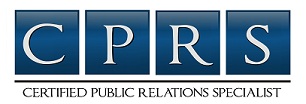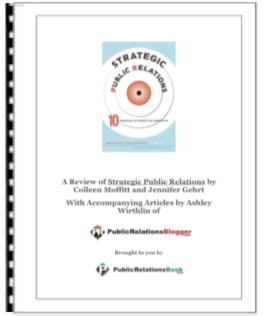________________________________________________________________________
 Public relations is the art, as one of my colleagues put it, of "offering people
Public relations is the art, as one of my colleagues put it, of "offering people
reasons to persuade themselves." In other words, we are not Madison Avenue;
we don't tell people what we want them to think. Rather, we give them
evidence, facts, and opinions that help them reach a conclusion. If we're good
at what we do, they will reach the conclusion we've been hired to promote.
The differences between traditional public relations and Guerrilla P.R. are
relatively simple. First of all, public relations firms like mine are available to
people with a lot of money, because we charge what we consider to be
reasonable fees, which are out of reach of many small or one-person
businesses. So entrepreneurs and small business owners need to learn and
apply the same skills I use every day in service of their larger, more well-
heeled rivals. But these skills can't be used the same way, since they require
more money than most small businesses can afford. Not everyone can buy a
minute of time on network TV to get the message across.
That's where Guerrilla P.R. comes in. This down-and-dirty offspring of the
traditional method is based on an idea I developed called the Tiffany Theory.
The Tiffany Theory is an idea that sounds simple but, like most such theories,
is so basic it contains numerous truths.
My Tiffany Theory states that a gift delivered in a box from Tiffany's will have a
higher perceived value than one in no box or a plain box. That's not because
the recipient is a fool; it's because in our society, we gift-wrap everything: our
politicians, our corporate heads, our movie and TV stars, and even our toilet
paper. Tiffany paper places a higher perceived value on things.
In effect, what I do each day is gift-wrapping. I take a message and wrap it in
the finest paper from Tiffany's. No matter what the message may be, I try to
make it sound more appealing, more interesting, and more useful. If I do my
job correctly, the consumer (who gets the message through television,
newspapers, radio, or the Inter net) will get the message. But first, that
message has to go through editors, producers, reporters, and website
managers. The Tiffany paper adds perceived value and cachet.
Notice, now, I said, perceived value. In public relations and publicity,
perception is truth. It isn't what happened that counts, it's what people think
happened. This is the absolute day-to-day currency of politics, entertainment,
and most other industries. In our case, we're looking at how the public-that is,
the segment of the public you believe is your customer base-perceives your
company. Not what your company actually might be.
Does that mean you should lie? Never. Lying, besides being morally wrong, is
quite literally indefensible. That means, at some point, you're going to be
found out. And even if you weren't, you would have to start living the lie-
remembering what you told the people interested in your business, and
hearing people call you what you said you are. It's too hard, and it's not worth
it. Besides, it's plain bad business.
When I say that the perception of the truth-rather than the truth itself-is the
stuff of great publicity campaigns, I mean that the truth will take care of itself.
But you have to make sure that the image you project, the perception you offer
to potential customers, is what you want it to be.
For example, a man named Dave Schwartz decided he'd start a car rental
company that would lower rates to the consumer by featuring cars that weren't
100 percent new off the showroom floor. He had a choice to make in terms of
the perception of his new company, and he chose to beat critics to the punch
with a strong sense of humor and a catchy company name: Rent-A-Wreck.
Now, Dave didn't lie (his cars weren't wrecks, they drove just fine, so maybe he
exaggerated a little), and he didn't fall into the trap of emphasizing price. After
all, his competitors already had names like Thrifty and Budget. He hit you in
the funny-bone, made his impression of a fun car rental company-with the
implied promise that the cars would cost less because they weren't brand new-
and launched a very successful business.
It's all in the perception. But is this a contradiction of the Tiffany Theory? Did
Dave actually wrap his cars in Kmart paper to make his point?
Not really. Dave still wrapped his message in Tiffany paper. He made sure local
news outlets, publications, and media companies knew about his company,
and he emphasized exactly how reliable and economical the rental cars at
Rent-A-Wreck would be. By downplaying the appearance of the cars-calling
them "wrecks" he allowed the media to expect dented, scratched, beat-up cars.
When they toured his facility and saw cars that were only slightly used, Dave
didn't have to say a word. The message got out that the "wrecks" in question
were very reliable, attractive cars that would be available for a lower rental rate
because they were used. A brilliant, subtle piece of Tiffany wrapping.
----------------------------------------------------------
The Tiffany Theory applies to the Internet in ways it never could with traditional
media. Keep in mind that more information is available on the World Wide Web
than you can possibly track, let alone control. So it's always important to keep
your information true. But unlike information in newspapers or magazines, the
data you provide on a website is yours, and you provide the Tiffany paper. Use
photographs, charts, quizzes, and prizes, if you can, to keep surfers' interest
alive on your site. And remember to wrap every fact in a nice neat piece of
Tiffany wrap.
GuerrillaPR Insights is a, weekly newsletter that does 2 things: First, it provides readers with a weekly, actionable "insights" on how you can work more effectively with the media.
Secondly, it provides NAPES: Names, Addresses, and Phone numbers of key media producers and editors. For example, in a recent issue, we gave specific contact information on how to contact the producers of the Oprah Winfrey Show.
To check out the archives, click here.
Article Source.
Tags: guerilla pr, public relations, alternative marketing methods
What are Guerilla Public Relations?
________________________________________
 Public relations is the art, as one of my colleagues put it, of "offering people
Public relations is the art, as one of my colleagues put it, of "offering peoplereasons to persuade themselves." In other words, we are not Madison Avenue;
we don't tell people what we want them to think. Rather, we give them
evidence, facts, and opinions that help them reach a conclusion. If we're good
at what we do, they will reach the conclusion we've been hired to promote.
The differences between traditional public relations and Guerrilla P.R. are
relatively simple. First of all, public relations firms like mine are available to
people with a lot of money, because we charge what we consider to be
reasonable fees, which are out of reach of many small or one-person
businesses. So entrepreneurs and small business owners need to learn and
apply the same skills I use every day in service of their larger, more well-
heeled rivals. But these skills can't be used the same way, since they require
more money than most small businesses can afford. Not everyone can buy a
minute of time on network TV to get the message across.
That's where Guerrilla P.R. comes in. This down-and-dirty offspring of the
traditional method is based on an idea I developed called the Tiffany Theory.
The Tiffany Theory is an idea that sounds simple but, like most such theories,
is so basic it contains numerous truths.
My Tiffany Theory states that a gift delivered in a box from Tiffany's will have a
higher perceived value than one in no box or a plain box. That's not because
the recipient is a fool; it's because in our society, we gift-wrap everything: our
politicians, our corporate heads, our movie and TV stars, and even our toilet
paper. Tiffany paper places a higher perceived value on things.
In effect, what I do each day is gift-wrapping. I take a message and wrap it in
the finest paper from Tiffany's. No matter what the message may be, I try to
make it sound more appealing, more interesting, and more useful. If I do my
job correctly, the consumer (who gets the message through television,
newspapers, radio, or the Inter net) will get the message. But first, that
message has to go through editors, producers, reporters, and website
managers. The Tiffany paper adds perceived value and cachet.
Notice, now, I said, perceived value. In public relations and publicity,
perception is truth. It isn't what happened that counts, it's what people think
happened. This is the absolute day-to-day currency of politics, entertainment,
and most other industries. In our case, we're looking at how the public-that is,
the segment of the public you believe is your customer base-perceives your
company. Not what your company actually might be.
Does that mean you should lie? Never. Lying, besides being morally wrong, is
quite literally indefensible. That means, at some point, you're going to be
found out. And even if you weren't, you would have to start living the lie-
remembering what you told the people interested in your business, and
hearing people call you what you said you are. It's too hard, and it's not worth
it. Besides, it's plain bad business.
When I say that the perception of the truth-rather than the truth itself-is the
stuff of great publicity campaigns, I mean that the truth will take care of itself.
But you have to make sure that the image you project, the perception you offer
to potential customers, is what you want it to be.
For example, a man named Dave Schwartz decided he'd start a car rental
company that would lower rates to the consumer by featuring cars that weren't
100 percent new off the showroom floor. He had a choice to make in terms of
the perception of his new company, and he chose to beat critics to the punch
with a strong sense of humor and a catchy company name: Rent-A-Wreck.
Now, Dave didn't lie (his cars weren't wrecks, they drove just fine, so maybe he
exaggerated a little), and he didn't fall into the trap of emphasizing price. After
all, his competitors already had names like Thrifty and Budget. He hit you in
the funny-bone, made his impression of a fun car rental company-with the
implied promise that the cars would cost less because they weren't brand new-
and launched a very successful business.
It's all in the perception. But is this a contradiction of the Tiffany Theory? Did
Dave actually wrap his cars in Kmart paper to make his point?
Not really. Dave still wrapped his message in Tiffany paper. He made sure local
news outlets, publications, and media companies knew about his company,
and he emphasized exactly how reliable and economical the rental cars at
Rent-A-Wreck would be. By downplaying the appearance of the cars-calling
them "wrecks" he allowed the media to expect dented, scratched, beat-up cars.
When they toured his facility and saw cars that were only slightly used, Dave
didn't have to say a word. The message got out that the "wrecks" in question
were very reliable, attractive cars that would be available for a lower rental rate
because they were used. A brilliant, subtle piece of Tiffany wrapping.
----------------------------------------------------------
The Tiffany Theory applies to the Internet in ways it never could with traditional
media. Keep in mind that more information is available on the World Wide Web
than you can possibly track, let alone control. So it's always important to keep
your information true. But unlike information in newspapers or magazines, the
data you provide on a website is yours, and you provide the Tiffany paper. Use
photographs, charts, quizzes, and prizes, if you can, to keep surfers' interest
alive on your site. And remember to wrap every fact in a nice neat piece of
Tiffany wrap.
GuerrillaPR Insights is a, weekly newsletter that does 2 things: First, it provides readers with a weekly, actionable "insights" on how you can work more effectively with the media.
Secondly, it provides NAPES: Names, Addresses, and Phone numbers of key media producers and editors. For example, in a recent issue, we gave specific contact information on how to contact the producers of the Oprah Winfrey Show.
To check out the archives, click here.
Article Source.
Tags: guerilla pr, public relations, alternative marketing methods
Popular choices
- Non Gamstop Casino
- Mejores Salas De Póker
- Non Gamstop Casinos
- Siti Casino Online Non Aams
- Migliori Siti Casino Online
- UK Online Casinos Not On Gamstop
- Non Gamstop Casino Sites UK
- Non Gamstop Casino Sites UK
- UK Casino Not On Gamstop
- Casinos Not On Gamstop
- Online Casino
- オンラインカジノ
- UK Casino Not On Gamstop
- UK Casino Not On Gamstop
- Reputable Non Gamstop Casinos
- Casinos Not On Gamstop
- Best Non Gamstop Casinos
- Non Gamstop Casino
- Casinos Not On Gamstop
- Slots Not On Gamstop
- Non Gamstop Casino
- Casino Non Aams
- Casinos Not On Gamstop
- Betting Sites Not On Gamstop
- Casino Online Italia
Subscribe to:
Post Comments (Atom)






Comments (0)
Post a Comment